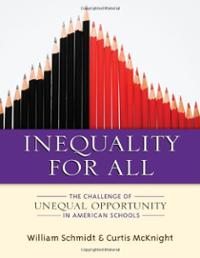 Inequality for All: The Challenge of Unequal Opportunity in American Schools |
This wonky but important (and exceptionally timely) book by Bill Schmidt, a Michigan State “university distinguished professor,” and Curtis McKnight, an emeritus math professor at the University of Oklahoma, is a distinctive, deeply researched, and amply documented plea for full-scale implementation of the Common Core math standards. The authors reach that destination after taking readers on a fascinating curricular journey.
They closely examine the extent to which young Americans in various states, districts, schools, and classrooms have equal opportunities to learn the same high-quality math content in grades K–8—and find grievous gaps and injustices.
One might suppose that this most hierarchical and standardized of core subjects would yield the greatest uniformity from place to place within the United States. Critics of national curricula (and the Common Core) periodically declare that NAEP, the textbook oligopoly, the NCTM, and college-entrance exams have caused math curricula to be very similar across the land.
Schmidt and McKnight, however, show conclusively that this presumption is false. And they link the variation they identified in content coverage and delivery to the country’s vexing achievement gaps, its deteriorating social mobility, and its generally weak educational performance. Here are a few excerpts from the book’s alarming—and stirring—final chapter:
The inequalities in content coverage begin with the state and local community in which a child is to attend school…and continue with the neighborhood school to which the child is assigned. Furthermore, two children, even from the same family and attending the same school but with different teachers for each of the first five grades, are not likely to have the same learning opportunities….A topic can be covered or not covered. Topics can be studied in different sequences, some of which may not make any sense from the point of view of the content itself. Students can receive more or less time for instruction, depending on the teacher’s decision. All of these differences in content coverage can be found in the varying experiences of children from different families who live in different regions of the state or country…
Further complicating the expression of clear and coherent intentions for classroom content coverage is that textbooks and tests instantiate their own sense of which topics should be learned…
For U.S. children, the nation is by no means indivisible. The data we presented…show the extent to which the nation’s children are divided by different content exposures in mathematics and science. These content learning opportunities define the core of schooling. Since there are so few guarantees for equivalent learning opportunities, public schooling has become more like a game of chance. It clearly does not embody "equality for all," but instead "inequality for all."
Uniform standards such as those in the Common Core won’t solve this set of problems in and of themselves. But without such standards, it’s not likely ever to be solved.
